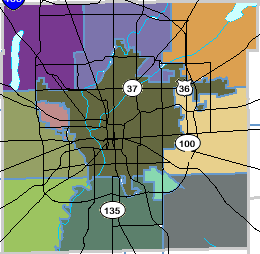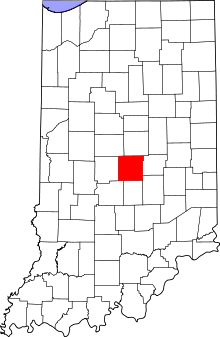Indianapolis Public Schools
| Indianapolis Public Schools (IPS) | |
|---|---|
| Type and location | |
| Grades | K–12 |
| Region | City of Indianapolis |
| Country | The United States Of America |
| Location |
120 East Walnut Street Indianapolis, Indiana |
| District information | |
| Superintendent | Dr. Lewis D. Ferebee (September 2013) |
| Students and staff | |
| Students | 33,372 [1] |
| Teachers | 2,452 |
| Staff | 4,090 |
| Athletic conference |
IPS Conference Pioneer Conference |
| District mascot | |
| Other information | |
| 2009 Graduation Rate | 49.8% [2] |
| 2009 Graduates | 1,159 |
| Website |
www |


Indianapolis Public Schools, abbreviated locally as IPS, is the largest school district in Indianapolis as well as in the state of Indiana with 33,372 students enrolled in 2009-2010.[3] Its headquarters are in the John Morton-Finney Center for Educational Services.[4] The district's official name is The School City of Indianapolis and is governed by a seven-member Board of School Commissioners.
The district operates 64 schools, including three traditional high schools (Grades 9-12), four community high schools (Grades 7-12), two middle schools (Grades 7-8), 49 elementary schools (Grades K-6), one K-12 school (Key Learning Community), one Grade 2-8 school (Sidener Academy) and three alternative schools.[5] IPS is the only school corporation in central Indiana to offer magnet/option programs at no cost to students.
History
Foundation
Indiana was admitted to the Union in 1816, with Indianapolis receiving its charter in 1847. That year, thanks to the efforts of residents including Caleb Mills (for whom the current Shortridge High School Auditorium is named), the people of Indiana voted in favor of public schools. A tax levy of 12½ cents per $100 of assessed valuation of property tax was established. In 1853 Indianapolis incorporated its school system. The city's first high school opened that year in the Marion County Seminary building on the southwest corner of University Park. The enrollment was 115 students. In 1858, the Indiana Supreme Court ruled it unconstitutional for cities and towns to levy taxes for the support of public schools, and all public schools were closed and rented to teachers. In 1860, elementary schools reopened. In 1895, Manual Training High School, later to be known as Emmerich Manual High School, was opened. In 1912, Arsenal Technical High School was opened on the grounds of the former U.S. Arsenal at Indianapolis. During the early part of the 20th century, IPS expanded its boundaries to include outlying areas of the still-growing city.
Early expansion
During the 1920s, when Indianapolis made significant annexations, the district incorporated towns such as Broad Ripple, and added their schools into the district. In 1927, Crispus Attucks High School opened as the only all African-American high school in the state of Indiana with 1,350 students while anticipating only 1,000. Other new schools also were built during this period, including Thomas Carr Howe and George Washington high schools.
Later growth and difficulties
The next wave of annexation came during the 1950s and 1960s, when hitherto-unprecedented enrollment levels occurred. Three high schools were constructed in a period of seven years: Arlington in 1961, Northwest in 1963, and John Marshall in 1968.
During the 1960s IPS began to face major challenges. Entrenched institutional racial segregation and economic decline of the city proper were both at the root of serious problems. As in other cities, African-Americans had long been segregated away from students of other racial backgrounds, and the movement of Caucasian citizens to suburbs outside of IPS jurisdiction increased the division. These problems became more acute as economic opportunities in Center Township, the core of IPS, deteriorated.
In 1971, U.S. District Judge S. Hugh Dillin found IPS guilty of de jure segregation, by which it was meant that explicit boundaries within IPS had been drawn apparently upon racial bases. This legal decision no doubt contributed to the phenomenon of "white flight" from Indianapolis, but it would be simplistic to reduce such a broad demographic shift to a single issue.
Nevertheless, schools such as Broad Ripple High School went from having virtually no black students in 1967 to becoming 67% African-American by 1975. As the population of Indianapolis became less and less concentrated within the IPS district proper, administrators had to undertake the unpleasant task of closing schools. For example, John Marshall High School, built in 1968, closed only eighteen years later in 1986.
Between 1971 and 2005 the district lost nearly 70,000 students and closed some 100 schools, including six high schools: Harry E. Wood in 1978; Shortridge (which reopened as a middle school) in 1981; John Marshall in 1987; Attucks in 1986 (which also reopened as a middle school); George Washington and T.C. Howe in 1995, which both reopened their doors in 2001.
Beginning in 1981, due to additional federal court mandates, some 7,000 African-American students began to be bussed from IPS to schools in the Decatur, Franklin, Perry, Warren, Wayne and Lawrence township school corporations within Marion County. In 1998, an agreement was reached between Indianapolis and the United States Department of Justice to phase out inter-district, one-way busing. By 2005, the six township school districts no longer received any new IPS students.
Throughout the 1990s, worsening budgets contributed to problems common to inner city school districts. While the city had a graduation rate higher than the national average in the 1950s, it now had the worst dropout rates in the state. Test scores declined precipitously.
Attempts at regeneration
Citizens' task forces studied how to combat school violence, low academic achievement, and persistent racial segregation. In 1992, then-superintendent Shirl Gilbert initiated a "Select Schools" plan, allowing parents the option of selecting which school they wanted their child to attend within the district. While theoretically promising, in practice the plan did not lead to general improvements.
Dr. Gilbert was forcibly removed from his post by the school board in 1994 and replaced with Esperanza Zendejas in 1995. Dr. Zendejas pursued an aggressive program of reform and improvement, removing several administrators from their positions and attempting to implement performance standards upon remaining school administrators. After repeated conflicts with administrators, school board members and parents Dr. Zendejas resigned from her post in 1997.
The succeeding superintendent was Duncan N.P. "Pat" Pritchett, who had occupied the superintendent's seat in a locum tenens capacity between Drs. Gilbert and Zendejas. Under both Drs. Gilbert and Zendejas, Mr. Pritchett was an assistant superintendent for facilities management. There was some opinion at the time of his appointment that he was brought on primarily for his affability after the stormy tenures of Gilbert and Zendejas. (The then-president of the Indianapolis Urban League referred to Mr. Pritchett as "same soup warmed over again".) Under Pritchett, the district saw eight years of steady academic improvement thanks to a number of initiatives, including a partnership with the National Urban Alliance to strengthen literacy and a math/science initiative that set algebra as the eighth-grade gateway math course. Pritchett also brought the concept and planning of Small Schools to the district's traditional comprehensive high schools, turning five campuses into 24 schools within a school.
Upon Pritchett's retirement in 2005, the post was offered to and accepted by Dr. Eugene G. White, who had been serving as superintendent of the Metropolitan School District of Washington Township within Marion County. Dr. White began to implement several reforms, including re-establishing high school programs at two historic schools (Crispus Attucks and Shortridge) as academies devoted to medicine and law/government, respectively. In August 2006, Dr. White informed IPS middle school principals that their continued employment depends upon improvement in discipline and test scores.
Infrastructure/Capacity
As of 2006, approximately 36,000 students were in IPS. Many of the facilities in IPS were outdated and in need of renovation; some facilities being over 70 years old. In 2001, the IPS Board of School Commissioners approved an $832 million plan to upgrade each of the district's 79 schools, in some cases totally replacing outdated buildings with new facilities. The plan has been completed within the last few years.
Academic/Safety Challenges
The IPS district lost some schools to outside groups for the improvement of academic and overall performance. Charter Schools USA took over three locations, while the other is currently administered by Ed-power. These schools that are now privately run include: Emma Donnan Middle School, Emmerich Manual High School, Thomas Carr Howe Community High School, and Arlington High School.[6] [7]
High schools
Indianapolis Public Schools maintains eight public high schools that go up to twelfth grade, although they do not necessarily start at the ninth grade. They are as follows:
| official full name | Nickname | Grades | School-Wide Magnet |
|---|---|---|---|
| Arsenal Technical High School | Tech | 9-12 | no |
| Broad Ripple Magnet High School for the Arts and Humanities | Ripple | 6-12 | yes |
| Crispus Attucks Medical Magnet High School | Attucks | 6-12 | yes |
| John Marshall Community High School | Marshall | 7-12 | no |
| Northwest High School | Northwest | 9-12 | no |
| Shortridge Magnet High School for Law and Public Policy | Shortridge | 6-12 | yes |
| George Washington Community High School | Washington | 7-12 | no |
| Key Learning Community | Key | K-12 | yes |
References
- ↑ http://compass.doe.in.gov/Dashboard.aspx?view=CORP&val=5385&desc=Indianapolis%20Public%20Schools
- ↑ http://mustang.doe.state.in.us/SEARCH/snapcorp.cfm?corp=0235
- ↑ http://compass.doe.in.gov/Dashboard.aspx?view=CORP&val=5385&desc=Indianapolis%20Public%20Schools
- ↑ "About Us." Indianapolis Public Schools. Retrieved on June 19, 2013. "Main Office The John Morton-Finney Center for Educational Services 120 E. Walnut St., Room 114 Indianapolis, IN 46204"
- ↑ "IPS Factsheet" (PDF). Retrieved 2009-02-26.
- ↑ http://www.indystar.com/article/20121031/NEWS04/121031015/A-F-school-accountability-grades-not-scary-expected. Missing or empty
|title=(help) - ↑ (PDF) http://www.doe.in.gov/sites/default/files/sboe/edpowerpresentation.pdf. Missing or empty
|title=(help)
External links
- Indianapolis Public Schools Profile
- Indianapolis Public Schools Website
- Teaching the whole child an IPS success story
| ||||||